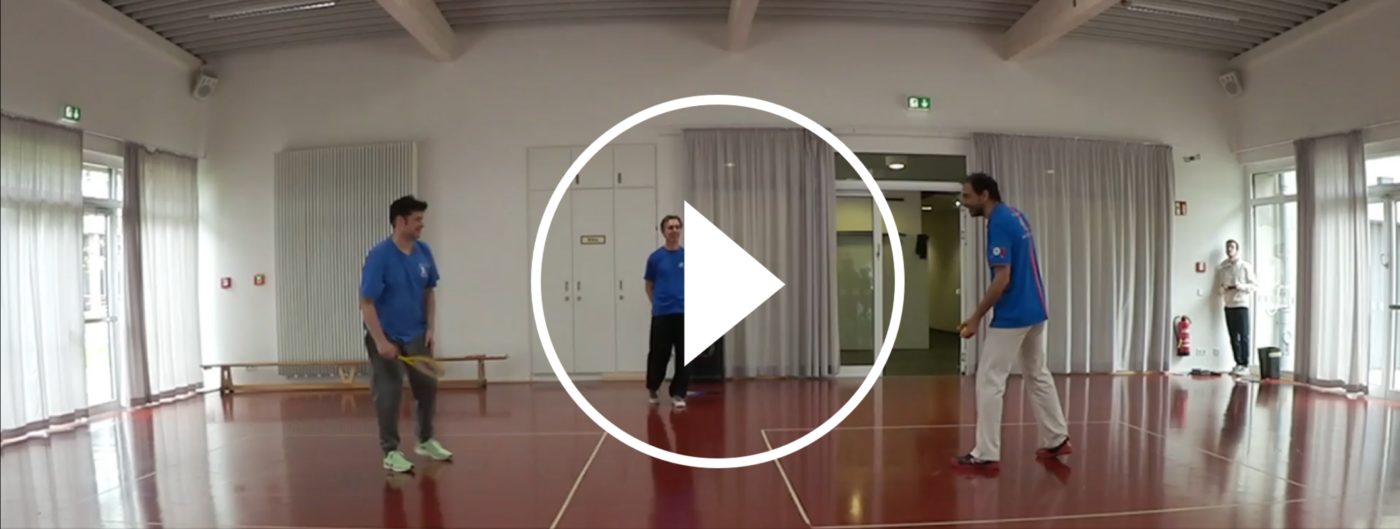Your goal is to win 2 sets and thus the match. To do this, you have a serve as well as a multitude of other moves at your disposal, which you use as well-placed as possible, if necessary surprisingly as well as quickly. Pay attention that the ball leaves your racket in a horizontal or upward trajectory. It if does not, your competitor scores. If your opponent does not reach the ball before it hits the ground or your opponents ball is out of bounds, you score.
Rules
The game is played best of three sets. A set is won with 15 points and at least a two point lead. With a one point lead, the first athlete to reach 20 points wins the set.
The Court
- Both court halfs are each 3 meters long and 3 meters wide
- The court halfs are 1.5 meters apart
- The entire court should be free-standing within a radius of at least 1m
- The ceiling height must be at least 6m
- All lines are at least 2cm thick.
General Rules
Scoring
Balls that bounce inside or on the court boundaries on the opponent’s side.
In order to maintain the flow of the game, the main referee may warn a player doing invalid moves with a shout or to award a point directly to the opponent in case of gross mistakes. After three warnings, a point is automatically awarded to the opposing party.
Errors
- Balls touching the floor outside the court boundaries on the opponent’s side (out ball)
- Balls that are not caught or returned on your own side of the court
- Balls that touch anything other than the racquet blade during rallies (e.g., clothing, body parts, etc.)
- Balls where the racquet grazes / touches the ground during the swing process
- Balls where the player’s racquet touches a part of the body or clothing.
- Balls where the player steps on a line or outside of the own court half’s boundary
- Balls in which the player takes more than one step after the ball is on the racquet blade
- Balls where the acceleration distance or the swing distance is more than 360°
- Balls leaving the racket in a downward trajectory, thus, not horizontally or in an upward trajectory
Serve
The serve takes place upon the referee’s signal / blowing of the whistle.
The player serves out of the own court half. At least one foot must stay in constant contact with the ground during the serve. One hand throws the ball high and to the back, whereby the ball must cover a distance of at least 30cm. The other hand lets in the ball with the racquet. By a correct execution of the round swing process, the ball is played to the other court half. Only the high and low flying serve (high forehand and backhand) is allowed.
The player awaiting the serve may not deliberately swing the racquet around, shout loudly, or move on his court to the point of impairing or interfering with the opponent’s serve.
Incorrect Serves
- the player does stands outside his own field or on a line
- the player does not throw the ball clearly beyond 30cm
- the player moves both feet during the serve, losing contact with the ground
- the player jumps up or turns the racket during the serve
the player applies an incorrect swing technique after the ball is on the racquet blade, such as:- interrupted swings
- pushing, shaking or lifting the ball
- the ball does not reach the racket blade or it cannot be released out of the racket
- the ball touches the ground outside the opponent’s court half
- The high throw-in and low let-out swing technique is not used
Updates and Blogs
Here you can find updates and blog posts covering these disciplines.
Updates & Blogs






